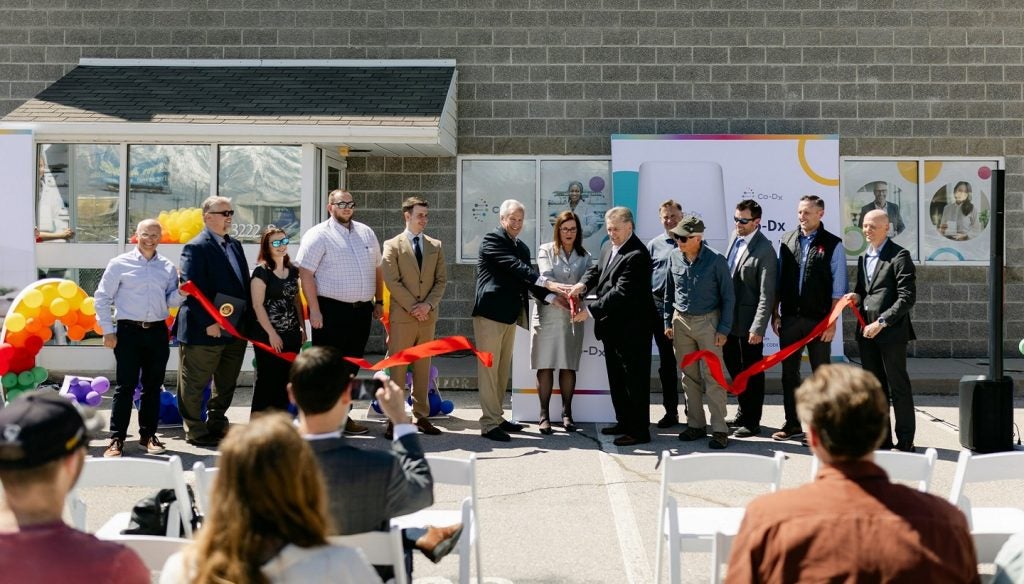
As a concept, transcatheter aortic valve replacement may not be brand spanking new – the first procedure was carried out in France back in 2002 – but as it gradually becomes more commonplace and more widely practised by surgeons in patients who otherwise face very high risk for open heart surgery, it promises to have profound ramifications for patients, surgeons and device manufacturers alike.
Aortic valve disease, or stenosis, is the narrowing of the aortic valve caused by degeneration of the valve tissue, which can in turn put pressure on the heart and force it to work harder, so raising the risk of wider heart disease or, ultimately, heart failure. It is the most common heart valve disease in the UK and predominantly affects elderly people, with some 18,000 aortic valves replaced in the UK in the past year.
Transcatheter aortic valve implantation is an alternative treatment to the conventional surgical valve replacement for patients suffering from aortic stenosis. The procedure is performed through a sheath, which is inserted either into a large blood vessel, usually in the groin area (also called a transfemoral approach), or directly into the heart (also called a transapical approach).
A replacement valve mounted on a catheter is inserted through this sheath and placed into the faulty valve after this is widened. The transfemoral approach is usually performed by a cardiologist as the primary investigator and the transapical approach by a cardiac surgeon, however, close collaboration is mandatory for success.
The first two successful transapical aortic valve replacements in the UK were carried out in August 2007 by a team from King's College, London, led by cardiac surgeons Mr Ahmed El-Gamel and Mr Olaf Wendler, and cardiologists Dr Martyn Thomas and Dr Phil MacCarthy. They carried out two transapical aortic valve replacements, using keyhole surgery, through a small hole in the chest just above the apex of the heart, and two percutaneous or transfemoral aortic valve replacements, implanting the replacement valve through the femoral artery.
See Also:
In both cases, a balloon was inserted into the native, narrowed heart valve and inflated, pushing the existing valve's tissue flaps against the aortic wall. The balloon was then removed and the replacement valve was compressed and crimped on a catheter. This was placed into the existing valve using the sheath in the groin or the apex of the left heart. After placement the new valve was deployed and left to start working.
How well do you really know your competitors?
Access the most comprehensive Company Profiles on the market, powered by GlobalData. Save hours of research. Gain competitive edge.

Thank you!
Your download email will arrive shortly
Not ready to buy yet? Download a free sample
We are confident about the unique quality of our Company Profiles. However, we want you to make the most beneficial decision for your business, so we offer a free sample that you can download by submitting the below form
By GlobalDataFor the patient, the benefits are clear. There is no need for hugely invasive open-heart surgery requiring opening of the breast bone and the use of heart-lung machines. There is potentially much quicker recovery time, and many patients who otherwise faced very high risk for open heart surgery were discharged only a week after surgery.
For the clinician, too, while the procedure is challenging, it means patients previously thought too "high risk" for open-heart surgery can be reconsidered, and there is less (and often no) requirement for admission to an intensive care unit after surgery.
With aortic valve replacement still currently the only treatment for aortic stenosis, it opens the prospect of completely changing how this procedure is viewed.
Conventional valve replacement surgery has extended the lives of thousands of people with failing aortic heart valves since the early 1960s through the use of, as Wendler – who is also clinical director for cardiology and cardiothoracic surgery at King's College Hospital – explains, one of two options: a mechanical valve prosthesis made from carbon or metal, or a biological one, often pig, bovine or human.
The big advantage with the latter is that there is no requirement to take the anti-blood clotting drug Warfarin after surgery, but the disadvantage is that it is more likely to fail ten to 20 years after surgery, meaning the patient will require a replacement operation.
"At that point, of course, the person will be ten to 20 years older than they were at the first operation and so it can be more risky," says Wendler. "So this trans-catheter valve technique may change things even for the first operation done using open-heart surgery. If you use lower-risk surgery you will be able to make decisions sooner for younger patients and be more likely to be able to use a bio-prosthesis, so avoiding the need for Warfarin because the repeat operation is not going to be as difficult as in the past."
Ageing population
As the population demographic changes, with the prospect of more elderly people who will potentially be considered a higher risk, the option of a much less invasive approach may become increasingly attractive. Currently, it is estimated that nearly half of the 30–40% of patients with severe aortic stenois are not referred for surgery or denied surgery because they are considered too unwell to cope with the surgery. What's more, while the procedure itself is not cheap, it can also be an attractive option for the hospital management and accountants because the post-surgery care may become cheaper.
"You normally do not need a heart-lung machine for this type of procedure so, while buying the device does have high cost implications compared with a normal heart valve, offsetting that will be the fact that you will not need a heart-lung machine and the recovery period is potentially shorter," says Wendler. "This kind of treatment is very much a future market, and whenever you have future markets, you have new products. The initial cost of treatment may be higher than the cost of conventional surgery, but the after-surgery costs will hopefully be much less."
The main players
There are two main devices for this type of procedure on the market, manufactured by Edwards Lifesciences and Medtronic CoreValve. The Edwards balloon-expandable Sapien device, which is what was used at King's, is the only one that offers a transapical option at present, says Wendler, although it can be delivered through either the left ventricle apex or through the groin. "This is particularly helpful, because in these patients you often find small or diseased groin arteries and cannot bring it through that route, so half the time you will go through the heart apex," he says.
The replacement valve is mounted on a balloon on the tip of the device, which is then directly inserted into the patient. "By inflating the balloon of the device itself, you deploy the valve, which is completely different to the normal heart valve or surgical valve. You cannot buy the heart valve without buying the device – they come as a package," explains Wendler.
As with any groundbreaking procedure, there is also a great deal of training and education that has to come with it. Edwards Lifesciences has established a Sophus-based simulation training programme for surgeons and cardiologists, as well as all the relevant technology, imaging and anaesthesia specialists, which is designed to guide the specialists through the procedure. "It is a very sophisticated technique that needs a particular training programme. It is a team approach, between cardiologists, surgeons, anaesthetists, heart valve imaging specialist, technicians and nurses," says Wendler.
While valve ballooning/widening as a procedure (also known as valvuloplasty) as been around since as early as 1913, the problem for the aortic valve always is that this approach has several negative side effects and also results in early re-narrowing of the aortic valve. Another complication with this approach is aortic regurgitation, where excessive dilation causes the valve to become leaky. When it comes to valve replacement, the first successful prosthetic aortic valve replacement was performed in 1961.
Although device technology is constantly evolving, mechanical aortic replacement devices built of carbon or other kind of metal material have tended to fall into one of three categories: ball and cage valves (or caged ball as they are also known), tilting disc valves and double or bi-leaflet valves. The ball and cage device has a silicon ball that moves inside a metal cage, the tilting disc valve has a disc that tilts to allow blood to flow across the valve and then closes to prevent back-leak, while the bi-leaflet valve has two leaflets that move apart to permit blood flow and swing shut again.
Californian devices company Edwards Lifesciences, which has been running the trial at King's College Hospital, received US Food and Drug Administration approval for its landmark Sapien transcatheter aortic heart valve technology back in March 2007. The device has two main delivery systems: the Edwards' RetroFlex transfemoral and the Ascendra transapical. The Sapien transcatheter aortic heart valve integrates balloon-expandable stent technology with a replacement tissue heart valve.
The Sapien valve is compressed onto the balloon to the approximate diameter of a pencil and threaded through the patient's circulatory system from either the leg or inserted between the ribs and expanded directly over the aortic valve.
The valve is a proprietary technology designed to treat patients with severe aortic heart valve stenosis considered to be high risk for conventional open-heart valve replacement surgery. It was originally developed in conjunction with Professor Alain Cribier, chief of cardiology at the University Hospital in Rouen, France, who performed the first transcatheter valve replacement on the beating heart in April 2002.
The Medtronic CoreValve System uses transcatheter technology to permit aortic heart valve replacement using a beating-heart percutaneous procedure. It is comprised of an aortic tissue valve on a self-expanding frame, an 18 French size delivery catheter and a disposable loading system. Each component of the system has been designed to meet the requirements of a percutaneous implantation approach. The beating heart procedure also eliminates the need for special equipment and incisions required to access and support the heart, says the company.
With King's for one estimating that these new minimally invasive procedures could potentially help an additional 1,000–2,000 patients a year, the benefits are clear for the patients, clinicians, hospital administrators and device manufacturers that can embrace this brave new world.
As patient and medical need and appetite for such procedures increases, inevitably so too will the number of transcatheter heart valve devices that come on to the market, as Wendler concludes: "As demand for this type of procedure grows, so will demand for this type of device. It is expected that the number of these procedures will go up dramatically, so the device cost is likely to come down."




